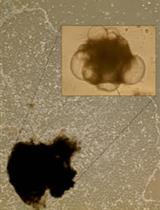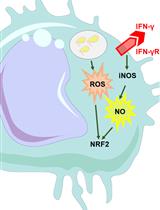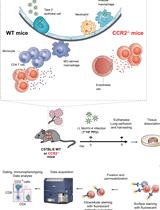- Submit a Protocol
- Receive Our Alerts
- EN
- EN - English
- CN - 中文
- Protocols
- Articles and Issues
- For Authors
- About
- Become a Reviewer
- EN - English
- CN - 中文
- Home
- Protocols
- Articles and Issues
- For Authors
- About
- Become a Reviewer
C1q Binding to and Uptake of Apoptotic Lymphocytes by Human Monocyte-derived Macrophages
Published: Vol 3, Iss 17, Sep 5, 2013 DOI: 10.21769/BioProtoc.877 Views: 8873
Reviewed by: Anonymous reviewer(s)

Protocol Collections
Comprehensive collections of detailed, peer-reviewed protocols focusing on specific topics
Related protocols

Differentiation of Human Induced Pluripotent Stem Cell into Macrophages
Harriet Douthwaite [...] Subhankar Mukhopadhyay
Mar 20, 2022 2223 Views

Continuous Measurement of Reactive Oxygen Species Formation in Bacteria-infected Bone Marrow–derived Macrophages Using a Fluorescence Plate Reader
Natascha Brigo [...] Christa Pfeifhofer-Obermair
Feb 5, 2023 624 Views

Functional Phenotyping of Lung Mouse CD4+ T Cells Using Multiparametric Flow Cytometry Analysis
Céline M. Maquet [...] Bénédicte D. Machiels
Sep 20, 2023 574 Views
Abstract
To characterize macrophage gene expression profiles during the uptake of autologous apoptotic cells, we developed a unique, more physiologic system using primary human monocyte derived macrophages purified via a nonactivating isolation procedure (and in the absence of contaminating platelets, which can release stimulating signals if activated) and autologous lymphocytes as a source of apoptotic cells. The use of autologous cells as the apoptotic target rather than transformed cell lines avoids antigenic stimulation from “nonself” structures at the HLA level but also from “altered self” signals due to the transformation inherent in cell lines.
Keywords: Apoptotic cell clearanceMaterials and Reagents
- Human peripheral blood
- RPMI1640 + L-Glutamine + HEPES (Life Technologies, catalog number: 22400-105 )
- FBS (inactivate for 30 min at 56 °C) (Hyclone defined FBS, catalog number: SH30070.03 )
- Penicillin/Streptomycin (Life Technologies, catalog number: 15070-063 )
- L-Glutamine (200 mM) (Life Technologies, catalog number: 25030-081 )
- 0.4% Trypan blue Solution (Sigma-Aldrich, catalog number: T8154 )
- HBSS (Corning/Cellgro, catalog number: MT-21-023-CV )
- PBS
- 25% Human Serum Albumin (HSA) (Plasbumin®-25) (Talecris Biotherapeutics, NDC number: 13533-684-20 )
- Recombinant human IL-2 (Peprotech, catalog number: 200-02 )
- Recombinant human M-CSF (Peprotech, catalog number: 300-25 )
- Bovine Serum Albumin (BSA) (albumin from bovine serum, lyophilized powder, ≥ 96%) (Sigma-Aldrich, catalog number: A2153-100G )
- C1q (Comptech, Texas, catalog number: A099 )
- PKH26 Red Fluorescent Cell Linker Kit for General Cell Membrane Labeling (Sigma-Aldrich, catalog number: PKH26GL )
- CellStripper Dissociation Reagent (Thermo Fisher Scientific, catalog number: 25-056-CI )
- Apoptosis detection kit (BioVision, catalog number: K101-100 )
- Anti-human C1q (Quidel, catalog number: A201 )
- FITC conjugated anti-mouse IgG (Jackson Immunoresearch, catalog number: 115-096-006 )
- FcR blocking reagent human (Miltenyi, catalog number: 130-059-901 )
- FITC conjugated anti-human CD11b (Life Technologies, catalog number: CD11B01 )
- FITC mouse IgG1 isotypes (Life Technologies, catalog number: MG101 )
- Fluorescein phalloidin (Life Technologies, catalog number: F432 )
- Stericup (Thermo Fisher Scientific, catalog number: SCGVU11RE )
- Prolong gold antifade reagent (Life Technologies, catalog number: P36930 )
- Ammonium Chloride (anhydrous)
- Potassium bicarbonate
- Disodium EDTA
- NaN3
- Trypsin
- Complete media (see Recipes)
- Phagocytosis buffer (see Recipes)
- ACK buffer (see Recipes)
- FACS buffer (see Recipes)
Equipment
- 50 ml conical tubes (Thermo Fisher Scientific, catalog number: 339653)–important as monocytes stick to other tubes
- 12 x 75 mm polypropylene round bottom sterile tube (Thermo Fisher Scientific, catalog number: 14-956-1D )
- 12 x 75 mm polystyrene round bottom tubes (Thermo Fisher Scientific, catalog number: 14-961-13 )
- Tissue culture plates and vented flasks (any size)
- Eppendorf microfuge tubes
- 12 mm cover slips (Thermo Fisher Scientific, catalog number: GG12 ), sterilize by soaking in 70% Ethanol for 2 x 5 min
- Non tissue culture treated 100 mm petri dish (Thermo Fisher Scientific, catalog number: 0875712 )–referred to as petri dishes
- Tissue culture hood
- Gamma-irradiator
- 5% CO2, 37 °C Humidified incubator
- Centrifuge for 50 ml conical tubes and 5 ml bottom round tubes
- Centrifuge with swinging bucket rotor for plates (Sorvall, model: RT7000 or equivalent)
- Optic and confocal fluorescence microscopes
- Hemocytometer
- Flow cytometer
- Automatic pipettes (full range volumes)
- Tips (full range volumes)
- 24-well plates
Procedure
- Lymphocyte isolation, staining and apoptosis induction.
- Collect the first two 50 ml effluent tubes from the elutriation, which contain lymphocytes (monocytes are retained in the elutriation chamber).
- Centrifuge lymphocyte suspension 10 min at 700 rpm (100 x g), RT (room temperature) to remove majority of platelets.
- Discard supernatant and pool cell pellets in 10 ml ACK buffer (to remove residual red cells). Incubate 2-5 min RT.
- Add 20 ml complete media.
- Centrifuge cell suspension 10 min at 700 rpm (100 x g), RT.
- Discard supernatant and resuspend the cell pellet in 20 ml HBSS. Count viable cell number using 0.4% Trypan blue solution, a hemocytometer chamber and an optic microscope.
- Centrifuge cell suspension 10 min at 700 rpm (100 x g), RT.
- Resuspend the lymphocytes at 1 million/ml in complete media in a vented tissue culture flask.
- Add 100 U/ml recombinant human IL-2.
- Incubate at 37 °C, 5% CO2 for 7 days.
- Centrifuge lymphocyte cell suspension 5 min 1,200 rpm (300 x g).
- Discard supernatant and wash cell pellet with 10 ml HBSS. Count viable cell number using 0.4% Trypan blue solution, a hemocytometer chamber and an optic microscope
- Centrifuge cell suspension 5 min 1,200 rpm (300 x g).
- Discard supernatant and resuspend 20 million lymphocytes in 1 ml diluent C of PKH26 Red Fluorescent Cell Linker Kit.
- Dilute 4 μl PKH26 dye in 1 ml diluent C (4 μM).
- Mix dye and cells (PKH26 at 2 μM final), invert the tube gently and incubate for 5 min RT.
- Add 2 ml FBS. Mix well. Incubate 1 min RT.
- Add 16 ml complete media. Mix well by inversion. Centrifuge cell suspension 10 min 1,200 rpm (300 x g).
- Discard supernatant and resuspend cell pellet in 10 ml complete media. Centrifuge cell suspension 10 min 1,200 rpm (300 x g).
- Repeat step 19 twice for a total of 3 washes.
- Count viable cell number using 0.4% Trypan blue solution, a hemocytometer chamber and an optic microscope.
- Resuspend PKH26-labeled lymphocytes at 2 million/ml (up to 50 million in 25 ml) in RPMI1640 media without FBS in a T25 vented tissue culture flask.
- Induce apoptosis by exposing lymphocytes to γ-irradiation (10 Gy).
- Incubate lymphocytes overnight 5% CO2, 37 °C in either complete media (for early apoptotic cells) RPMI without serum for late apoptotic cells at 2 million/ml.
- Collect the first two 50 ml effluent tubes from the elutriation, which contain lymphocytes (monocytes are retained in the elutriation chamber).
- Isolation and culture of monocytes
- After recovering monocytes from elutriation chamber, wash in HBSS, count, and resuspend at 0.5 million/ml in complete media (Day 0).
- Add 10 ml per 100 mm petri dish.
- Add recombinant human M-CSF to a final concentration of 25 ng/ml.
- Place at 37 °C, 5% CO2.
- After 3-4 days, add 5 ml fresh complete media (containing 25 ng/ml M-CSF) per plate.
- On day 6-8, discard media from plates and wash adherent cells twice with 5 ml HBSS.
- Discard last HBSS wash and add 5 ml CellStripper to the plates, incubate 20-30 min RT.
- Pipet up and down to detach the cells and transfer to 50 ml conical tube containing 25 ml prewarmed complete media (one tube = 5 plates, final volume 50 ml).
- Centrifuge cell suspension 1,200 rpm (300 x g), 5 min RT.
- Wash cell pellet twice with 10 ml HBSS, centrifuge cell suspension 5 min 1,200 rpm (300 x g).
- Count viable cell number using 0.4% Trypan blue solution, a hemocytometer chamber and an optic microscope.
- Plate human monocyte derived macrophages (HMDM) at 0.25 million/ml in complete media, 500 cells/mm2. For immunocytochemistry (ICC), plate cells in 24-well plates containing 12 mm coverslips (0.5 ml).
- Incubate at 37 °C, 5% CO2 overnight.
- After recovering monocytes from elutriation chamber, wash in HBSS, count, and resuspend at 0.5 million/ml in complete media (Day 0).
- C1q binding to apoptotic lymphocytes
- Transfer apoptotic lymphocytes to conical tube. Assess apoptosis by flow cytometry using the apoptosis detection kit from Biovision.
- Centrifuge cell suspension 5 min 1,200 rpm (300 x g).
- Discard supernatant and carefully resuspend lymphocytes in 10 ml prewarmed HBSS. Count ALL cells (viable and permeable) using 0.4% Trypan blue solution, a hemocytometer chamber and an optic microscope.
- Centrifuge cell suspension 5 min, 1,200 rpm (300 x g).
- Resuspend cell pellet at 5 x 106 cells/ml in HBSS/1%HSA in sterile 12 x 75 mm round bottom tube.
- Depending on the number of C1q coated apoptotic cells desired, add human purified C1q to a final concentration of 150 μg/ml. Pipet gently up and down or invert to mix.
- Incubate for 1 h at 37 °C, gently shake tubes every 15 min.
- Add 2 ml HBSS per tube and centrifuge cell suspension 5 min, 1,200 rpm (300 x g).
- Discard supernatant, add 2 ml HBSS per tube and centrifuge cell suspension 5 min, 1,200 rpm (300 x g).
- Resuspend cell pellet at desired concentration in phagocytosis buffer for uptake assay. Set aside 2 x 105 apoptotic lymphocytes +/- C1q to assess C1q binding efficiency as described below.
- Transfer apoptotic lymphocytes to conical tube. Assess apoptosis by flow cytometry using the apoptosis detection kit from Biovision.
- C1q binding efficiency
- Resuspend 2 x 105 apoptotic lymphocytes +/- C1q in 100 μl FACS buffer.
- Add 1-2 μl murine anti-human C1q and incubate for 30 min on ice.
- Add 2 ml FACS buffer, centrifuge cell suspension 5 min 1,200 rpm (300 x g), 4 °C.
- Discard supernatant and resuspend cell pellet in 100 μl FACS buffer.
- Add 1 μl FITC conjugated anti-mouse IgG and incubate for 30 min on ice in the dark.
- Add 2 ml FACS buffer, centrifuge cell suspension 5 min 1,200 rpm (300 x g), 4 °C.
- Discard supernatant and resuspend cell pellet in 200 μl FACS buffer.
- Analyze by flow cytometry to determine C1q binding efficiency to apoptotic lymphocytes. Percentage of apoptotic cells binding C1q should be greater than 50%.
- Resuspend 2 x 105 apoptotic lymphocytes +/- C1q in 100 μl FACS buffer.
- Uptake assay
- Recover human monocyte derived macrophages (HMDMs) plate from Section C. Discard media and wash adherent cells twice with HBSS.
- Recover apoptotic lymphocytes from step IV-10. Add apoptotic lymphocytes +/- C1q at a 5:1 ratio (for example 5 x 105 apoptotic lymphocytes for 1 x 105 HMDMs in phagocytosis buffer in a final total volume of 2 ml per a 6-well plate well).
- Centrifuge the plate 3 min at 700 rpm (100 x g).
- Incubate for 1 h at 37 °C.
- To assess uptake by flow cytometry:
- Discard media and wash adherent cells twice with HBSS.
- Add 0.5 ml 0.05% trypsin and incubate 2 min 37 °C. Pipet cells up and down and transfer into 12 x 75 mm tubes (microscopically check that all macrophages have been recovered).
- Centrifuge cells 5 min 1,200 rpm (300 x g), RT.
- Discard supernatant and resuspend cell pellet in 100 ml FACS buffer.
- Add 5 μl CD11b-FITC antibodies per 1 x 106 cells, incubate 45 min in the dark on ice.
- Add 2 ml FACS buffer, spin down 5 min 1,200 rpm (300 x g) 4 °C.
- Centrifuge cells 5 min 1,200 rpm (300 x g), RT.
- Discard supernatant and resuspend in 300 μl FACS buffer to read.
- Analyze by flow cytometry.
- Discard media and wash adherent cells twice with HBSS.
- To assess uptake by ICC (using 12 mm coverslips placed in a 24-well plate).
- After step E-5, discard media and wash adherent cells twice with 0.5 ml HBSS.
- Fix cells with 3.7% formaldehyde (300 μl/well), 10 min RT.
Note: Do not use methanol or acetone as it can disrupt the PKH26 membrane labeling of apoptotic lymphocytes. - Wash cells twice with PBS.
- Stain cells with 4U FITC-phalloidin per well diluted in 250 μl PBS for 20 min RT.
- Wash cells twice with PBS.
- Mount coverslips with a drop of prolong gold antifade reagent.
- Analyze by fluorescence or confocal microscopy.
- After step E-5, discard media and wash adherent cells twice with 0.5 ml HBSS.
- Recover human monocyte derived macrophages (HMDMs) plate from Section C. Discard media and wash adherent cells twice with HBSS.
Recipes
- Complete media
RPMI1640 + L-Glutamine + HEPES (500 ml)
50 ml (10%) heat-inactivated FBS
5 ml (1%) Penicillin/Streptomycin
5 ml (1%) 200 mM L-Glutamine - Phagocytosis buffer
RPMI1640 + L-Glutamine + HEPES
25 mM HEPES
5 mM MgCl2 - ACK buffer
To 450 ml milliQ water add
4.145 g Ammonium Chloride (anhydrous)
0.5 g potassium bicarbonate
18.6 mg disodium EDTA
Adjust pH to 7.4
Bring final volume to 500 ml with milliQ water
Filter sterilize using stericup - FACS buffer
500 ml HBSS (no phenol red)
0.2% NaN3
0.2% BSA
Acknowledgments
Human peripheral blood lymphocytes and monocytes are isolated by counterflow elutriation using a modification of the technique of Lionetti et al. (1980) as described previously (Bobak et al., 1986).
References
- Benoit, M. E., Clarke, E. V., Morgado, P., Fraser, D. A. and Tenner, A. J. (2012). Complement protein C1q directs macrophage polarization and limits inflammasome activity during the uptake of apoptotic cells. J Immunol 188(11): 5682-5693.
- Bobak, D. A., Frank, M. M. and Tenner, A. J. (1986). Characterization of C1q receptor expression on human phagocytic cells: effects of PDBu and fMLP. J Immunol 136(12): 4604-4610.
- Lionetti, F. J., Hunt, S. M., Valeri, C. R. (1980). Methods of Cell Separation. New York: Plenum Publishing Corp.
Article Information
Copyright
© 2013 The Authors; exclusive licensee Bio-protocol LLC.
How to cite
Benoit, M. E., Clarke, E. V. and Tenner, A. J. (2013). C1q Binding to and Uptake of Apoptotic Lymphocytes by Human Monocyte-derived Macrophages. Bio-protocol 3(17): e877. DOI: 10.21769/BioProtoc.877.
Category
Immunology > Immune cell function > Lymphocyte
Immunology > Immune cell function > Macrophage
Do you have any questions about this protocol?
Post your question to gather feedback from the community. We will also invite the authors of this article to respond.
Tips for asking effective questions
+ Description
Write a detailed description. Include all information that will help others answer your question including experimental processes, conditions, and relevant images.
Share
Bluesky
X
Copy link








